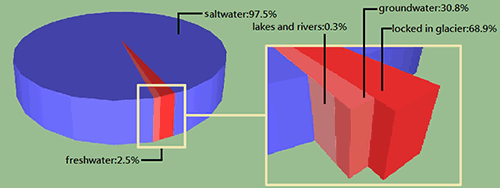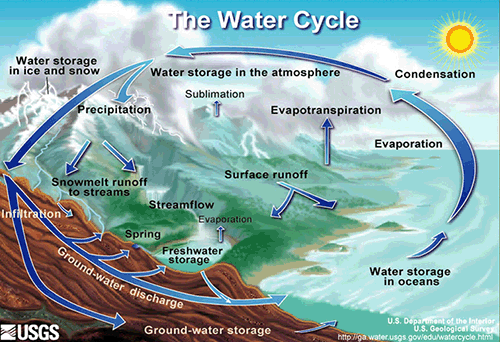Learn

Water Distribution
About 71% of the earth's surface is covered by water. Of that 71%, about 97% of the earth's water is found in the oceans, meaning that it is salt and unusable to humans and many other organisms. Freshwater makes up 3% of the water found on earth. Most of the freshwater is trapped in the icecaps in the north pole and the Antarctic and is not able to be used. Only about 0.3% of the water on earth is able to be used by humans.

This pie graph shows how water is distributed. Notice that freshwater is a very small slice of the availale water on Earth. Much of that freshwater is unavailable, as it is locked in glaciers.
The breakdown of water as given by the National Groundwater Association is
- Ocean Water: 97.2%
- Glaciers and other ice: 2.15%
- Groundwater,: 0.61%
- Fresh water lakes: 0.009%
- Inland seas: 0.008%
- Soil Moisture: 0.005%
- Atmosphere: 0.001%
- Rivers: 0.0001%.

Water Usage
As you can see from the information above, freshwater is very much a limiting factor and a precious commodity. As human populations grow and become more developed, water use keeps increasing. Water is used for industrial, agricultural, and residential purposes.
- Industries use water for manufacturing, processing, cleaning, cooling, and transporting items.
- Agriculture uses water for irrigating crops, watering livestock, and cleaning equipment.
- Residential uses of water are things like washing clothes and dishes, taking showers, brushing teeth, flushing toilets, cooking, filling swimming pools, watering lawns, household cleaning, and drinking.
- Water is also used in the production of electricity in thermoelectric plants, and mining. A thermoelectric plant is a power plant in which heat energy is converted to electric power. This would include coal, nuclear, natural gas, and oil. All of these require water for cooling.
All of these areas use water making less available for other organisms in the environment. These uses also can affect the quality of the water making it unable to be used by organisms. Worldwide agriculture accounts for 70% of the water usage, followed by industry with 20%, and residential with 10%.
Watch Show Me The Water (2:49) to see the water usage breakdown in the United States compared to that of worldwide use.
Developed countries use more water than developing countries because of their agricultural, industrial, and technological advancements. It is estimated that the United States uses about 3.9 trillion gallons of water per month. The average U.S. citizen uses about 176 gallons of water per day compared to only 5 gallons per day that the average African family uses.

Hydrologic Cycle
The hydrologic cycle also known as the water cycle: hydro-water is responsible for distributing water to different parts of the environment by re-circulating it. This cycle also helps renew and naturally remove some of the impurities in the water. Without the water cycle, life on earth would not be possible.
The water cycle does not have a natural beginning or end because all cycles are continuous. For our purposes we will start with surface water and trace the water movement through the environment.

This illustration shows the various paths water can take in the hydrologic cycle. See larger version.
Surface water is transported into the atmosphere through the process known as evaporation. Evaporation occurs on the top part/layer of surface water. The ocean makes up the largest part of surface water and about 86% of the evaporation on earth comes from the oceans. The sun's light energy causes the liquid water to turn to water vapor.
Water vapor is less dense than the atmosphere so it begins to rise. Water vapor continues to rise, losing heat energy to the surrounding atmosphere as it rises. When water vapor cools enough, it undergoes condensation the process of water vapor—a gas—undergoing a phase change because of energy loss and turning back to liquid water . If temperatures in the atmosphere become cold enough, this liquid could freeze and become ice or snow . When water condenses in the atmosphere, clouds are formed.
When the liquid (or ice) in the cloud becomes heavy enough, precipitation occurs. Precipitation can be in the form of rain, sleet, or snow. 78% of the precipitation on earth occurs over the oceans.
The water from precipitation hits the earth's surface and some of it soaks into the soil and enters the ground — through the process known as infiltration - where it is stored in large spaces/pockets within the earth's bedrock known as aquifers. This water is known as groundwater. Some of the water that lands on earth's surface does not make it to become groundwater. It gets trapped in the soil where it is taken in by plants. Plants use this water to help carry out such processes as photosynthesis. Water that is taken in by the plant exits a plant through its leaves in the process known as transpiration. During transpiration water leaves the plants in the form of water vapor.
Water from precipitation that does not soak into the soil enters surrounding lakes, streams, and rivers. This water that does not soak into the soil is called runoff. Areas on the surface that "funnel" runoff into nearby bodies of water are called watersheds.
Animals have access to the water and are able to drink it and use it for physiological processes, such as respiration. If you have noticed on cold mornings what looks like smoke coming out of your mouth when you exhale breathe out , this is water vapor that you are letting out turning into a liquid or solid form. Breathing is part of the respiration process where you take in oxygen that you need and let out carbon dioxide and water vapor that is not needed.
The water cycle is on a "loop" where water is changing states/phases through evaporation, condensation, freezing, and transpiration. With these phase changes, water is distributed to all parts of the environment.
Visit The Water Cycle for Schools and Students: Advanced students to review the different parts of the water cycle. Simply put your cursor over the boxed word and read more about it. You can learn more about the water cycle by visiting NASA: Precipitation Education.
 |
 |